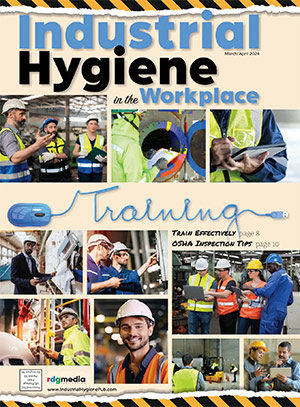What are Elastomeric Respirators?

Some elastomeric respirators, like the Comfort-Air® Series by Dentec Safety, are made for industrial use, while some, like the Comfort-Air®Nx & NxMD series, are made for healthcare workers, teachers and others. (photo courtesy Dentec Safety)
Elastomeric respirators are tight-fitting respirators that provide greater than N95-level protection and are made to be safely reused for years. You may be hearing more lately about elastomeric masks online and in the media. These types of reusable, rubber half-masks are nothing new and have been a staple piece of PPE for many workers across various industries for decades.
These reusable respirators are reliable, comfortable, cost-effective and safer than any disposable mask on the market. We’ve broken down everything you need to know about elastomeric respirators.
Elastomeric respirators are made by dozens of manufacturers and typically use N95, N99, N100 or P100 level filters. These are the most common reusable respirators found in homes and workplaces due to the added protection vs. disposableN95s. They are also more cost-effective, compared to disposable N95s.
These respirators are commonly found in mining, auto repair, construction, agricultural, pharmaceutical and home renovation industries. Rubber half-masks like these can be bought online or in your local hardware stores, including Canadian Tire, Lowes, Home Depot and Home Hardware. (Several provinces in Canada have massive stockpiles that were bought for healthcare workers that have been locked up for future pandemics since the first wave.)
Some elastomeric respirators are made for industrial use, while others are made for healthcare workers, teachers and others that need the best protection possible from deadly viruses, wildfire smoke, environmental allergens and more.
Facts About Elastomeric Respirators
- Hospitals have been successfully using reusable elastomeric respirators as superior alternatives to disposable Filtering Facepiece Respirator (FFR) N95s for infection control since 1996.
- Cities like Winnipeg, MB, Canada, have been using elastomeric respirators to protect firefighters, police and paramedics from Covid since March 2020.
- New York stopped buying FFR N95s for firefighters and EMS since November 2020 and upgraded everyone to elastomeric respirators instead.
- A study by the American College of Surgeons published in June 2020 shows that elastomeric respirators were so well-liked by the thousands of Health Care Workers (HCWs) that used them that, after the trial was finished, not one out of the 2,000 HCWs wanted to stop using them and go back to using disposable N95s. (See Dentec’s Cooper University Hospital: A Case Study on Elastomeric Respirators for Healthcare Workers)
- The CDC recommended elastomeric respirators as disposable N95 alternative during the SARS, H1N1 and for the Covid pandemic.
- An infectious disease specialist who informed the Biden administration, “there is no doubt that the lack of the more protective face masks contributed to those grim totals,” issued their own pandemic preparedness plan, which they called a “Road Map for Living with Covid.” Group leader, Dr. Ezekiel Emanuel, estimated that it will cost $100 billion or more to fully prepare the nation for future variants and pandemics moving forward.
The PPE section that starts on page 57, chapter 5, highlights the experts as follows:
- The supply chain of respirator manufacturing must be considered a national and economic security priority. Where necessary, domestic manufacturing capacity for respirators must be assured to safeguard sufficient supply for healthcare and other high-risk settings, with capacity to ramp up production during respiratory emergencies such as another pandemic or surge.
- The national stockpile should be replenished with elastomeric and powered air-purifying respirators for healthcare workers, which must be deployed immediately as future surges or pandemics occur.
- Healthcare workers with direct patient care responsibilities should top the priority list for personal protective equipment. They must be provided reusable respirators such as elastomeric half-mask respirators for the remainder of the pandemic.
- Workers in higher-risk settings need access to reusable respirators, such as EMS, food processing, assembly lines, grocers and warehousing, followed by workers in moderate-risk settings including restaurants, retail and transportation.
The Advantages of Elastomeric Respirators
- NIOSH Certified –Elastomeric respirators manufacturers MUST get their respirators approved by Health Canada and/or NIOSH. This eliminates the risk of fraudulent and unsafe products flooding the market and ensures high-grade protection that meets safety regulations and requirements.
- Source Control –Elastomeric respirators provide better source control than surgical masks and better protection from droplets and airborne transmissions vs. surgical masks and N95s.
- Domestic Supply Chain –Because elastomeric respirators are made in America by manufacturers like Dentec Safety, they can take away our dependency on foreign suppliers, create more jobs for North American workers and prevent disruptions along the domestic supply chain by preventing infections—which would also help stabilize the economy and reverse the rise in inflation.
- Reduce Counterfeit Products –The widespread adoption of elastomeric masks can eliminate the need for importing KN95s, which the CDC says six out of 10 are counterfeit and the CBC has shown even large retailers and pharmacies have accidentally been selling counterfeit KN95s.
- Reusable and Safer! –Disposable N95 respirators DO NOT provide an effective seal when reused more than a handful of times. Although disposable respirators meet the OSHA requirements for respiratory protection where a half facepiece is needed, the challenge with any disposable respirator is the ability to conduct a proper fit check when entering a hazardous environment throughout the day, once a fit test has been conducted.
NIOSH-approved disposable respirators are unable to continue to provide an effective seal when reused. Consider when a worker who is fit-tested on a particular style of N95 disposable respirator then goes to work. They have to shape the respirator each time they don it to try to secure a fit.
Each time you shape the disposable respirator to fit around your nose, it reduces the integrity of the structural shape of the mask, which prevents it from providing an effective seal. The use of an elastomeric half-mask with the appropriate filters will allow the individual to conduct a fit-check every time the put on the mask. This helps ensure proper fit and protection. Two important studies were conducted to support this conclusion.
Case Study 1: Effectiveness of Elastomeric Half-Mask Respirators vs N95 Facepiece Respirators During Simulated Resuscitation
Conclusion: 36 participants that were fitted with EMHR had 0% fit failure. 28% of those fitted with an FFR had a fit failure[1].
Case Study 2: Failure Rates During Reuse of Disposable N95 Masks in Clinical Practice in the Emergency Department
Conclusion: Disposable N95 masks have significant failure rates following reuse in clinical practice. Healthcare personnel also performed poorly in assessing the integrity of the seal of their disposable respirators.[2], [3]
[1] https://www.ncbi.nlm.nih.gov/pmc/articles/PMC8202994/
[2] https://www.ncbi.nlm.nih.gov/pmc/articles/PMC8202994/
[3] https://jamanetwork.com/journals/jamanetworkopen/fullarticle/2777504?utm_source=twitter&utm_campaign=content-shareicons&utm_content=article_
engagement&utm_medium=social&utm_term=031821#.YFJnEbgpaVg.twitter
The Case for Elastomeric Masks
Better fit for all faces – NIOSH sizing protocols drastically underrepresent women and Asian face shapes and sizes for FFRs. Many elastomeric masks can come in two sizes to provide a better fit/seal qualities for all face shapes and sizes. And, unlike many disposable N95s, there are elastomeric masks in kid’s sizes available by some manufacturers.
More comfortable – Internal temperature recordings inside most elastomeric masks are 2° C cooler than wearing a disposable respirator including a surgical style mask. Say goodbye to face rash and mask acne when you switch to a reusable half-mask.
A sustainable solution – Elastomeric respirators can be safely reused for years, so they can provide long-term sustainability and be stored after use for future pandemics or emergency situations.
Less waste – Reusable half-masks can eliminate billions of disposable masks from littering streets, landfills, rivers, lakes and oceans. We can reduce landfill waste by millions of pounds annually; reduce incineration costs for mask disposal; and help reduce carbon emissions by moving away from mass use of disposables.
More cost-effective – Reusable half-masks provide the most cost-effective respiratory protection option for the public or employers. Cost no longer becomes a barrier to proper high-grade protection.
Can help schools and businesses stay open safely – The widespread use and adoption of reusable half-masks could help virtually eliminate workplace transmission and outbreaks, while ending the need for future closures and lockdowns. Providing employees with high-grade protection like elastomeric respirators can keep workers safe while working in close proximity to each other and save countless jobs.
Prevent future pandemics – By putting elastomeric respirators into widespread use around the world, we can stop transmission of dangerous viruses and prevent future pandemics from occurring.
Share on Socials!
How To Determine the Right PPE for Your Worksite
Safety Training Beyond 2022: Ergonomics, Preventing MSDs & Avoiding Common Mistakes
OSHA’s General Duty Clause and Lone Worker Safety
Leaders in Industrial Hygiene
Council for Accreditation in Occupational Hearing Conservation (CAOHC)
Subscribe!
Sign up to receive our industry publications for FREE!









